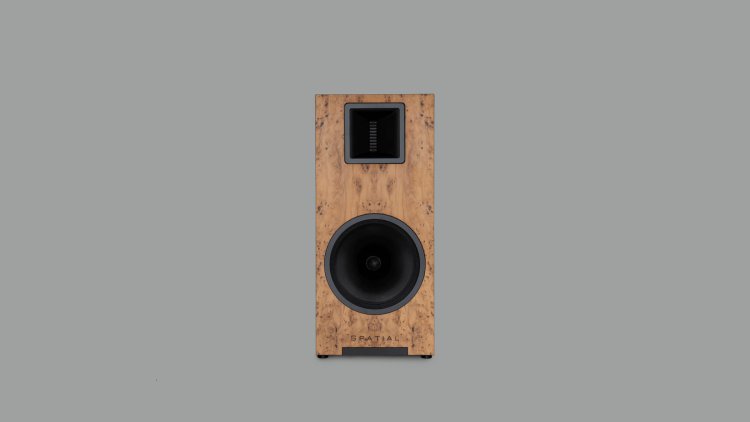Spatial Europe No.7: intensive experience

It is the antidote to the traditional box design, in which the cabinet prevents forward and backward radiated sound energy from canceling out. This effect, however, is only really relevant in the bass region since the wavelengths are large enough to bend over the baffle. The formula is frequency = wavelength x speed of sound in air (344 m/s).
For example, a frequency of 20 Hertz has a wavelength of around 17 meters, whereas the well-known concert pitch A (440 Hertz) has a wavelength of 78 centimeters.
And so the question is, how does Spatial Europe's mastermind, Robert Andorf, avoid this physical anomaly? No, it does not. But, of course, he considers this factor. In theory, dipole speakers create less bass than traditional loudspeakers, which can produce incredibly deep bass even at low volumes because the enclosure prevents an acoustic short circuit.

However, housings have significant drawbacks: they rattle, shake, resonate, and boom, giving the low tone an unnatural hue. Even the best cases, such as Magico, Wilson, Gauder, or Steinheim, are not exempt.
Essentially, the mantra is: The best-case scenario is no case. It is also reasonable to expect that such a baffle is vulnerable to resonance. However, this is not the case with the No.7: The slightly slanted panel is made up of two 38 mm thick MDF panels that have been strengthened and dampened. The N0.7's rich live weight (44.0 kg) is not just due to the bass…
However, the dipole radiator design adds another unique feature: although traditional "boxes" have essentially spherical bass radiation, that of a dipole mimics the shape of figure eight when viewed from above, the waist of which is the loudspeaker itself. Even in the bass, these structures have a club-like sound direction.
In the bass region, Robert Andorf used a 38-centimeter woofer from Acoustic Elegance in the United States. The characteristics of this bass are intended for outdoor installation, and in a dipole configuration, it delivers far more low bass than traditional hi-fi woofers. Anyone who gets a close look at the 38er will notice that it has a lot of expertise and quality packed into it.
Despite its small size, this driver is so good and low-resonance that it can run at 2,000 Hertz. It's no surprise, then, that this jewel is rather pricey to purchase. If Andorf used traditional hi-fi margins, the No.7 would almost certainly be far more expensive.
The woofer exemplifies a wonderful Spatial Europe criterion: all types are reasonably priced in their own right. The quality of the components, which Andorf utilizes out of conviction, would never be waved through by a huge corporation's controller. Spatial Europe, on the other hand, can and wishes to operate differently in this area, thanks to its caring hand-made production at Kreuzstraße 22a in Ingolstadt.

Long listening sessions are used to choose all electrical components, including basses, tweeters, capacitors, coils, and even resistors. In the case of Spatial Europe No.7, there was not only this powerful professional bass but also an efficient Air Motion Transformer (AMT) tweeter (also from the US American professional range), which has enough reserves for EVERY level orgy with a characteristic sound pressure of 102 decibels (1 watt / 1 meter). And a crossover was born that will make any connoisseur salivate.
The hand-wired 2-way filter is, of course, at the base of the dipole speaker and is not just unusual due to the quality of the components; Andorf normally goes for the top of the shelf in this regard.
Andorf has created one of the very few "serial" crossovers (by far the most loudspeakers in the world work with parallel crossovers). There isn't much basic theory concerning serial switches, but Andorf has a seasoned expert on hand.
The woofers and tweeters are actually connected in series with the serial crossover, while the appropriate filter components mostly work in parallel. The tweeter on the No.7, for example, is set to its operating frequency range of 2,000 Hertz through a parallel-connected notch filter.

The Spatial Europe No.7 is a dipole that emits the bass in a somewhat directed manner. In addition, we have a massive mid-bass driver in the baffle that, based on its proportions alone, begins focusing the sound about 350 Hertz and runs up to 2,000 Hertz. We also have a tweeter, which bundles rather powerfully because of the horn in front of it.
What should we make of this? Just one thing: here's the idea of sound packaging. The Spatial Europe No.7 illuminates the room in the manner of a tall torch with multiple LEDs stacked on top of each other: the cone is brilliant but tightly focused.
The measure of all tonal objects, according to most developers, is homogeneous, broad radiation. The No.7 also radiates very uniformly over the angles - albeit quite narrowly. This must be considered when setting up.
We quickly concluded that you can hear practically every degree with this speaker after finding the perfect setting. We took numerous steps to get there, but in the end, the exact alignment to the listening position in our listening room was just what we needed. Only then could the transparency that one would expect from such a renowned speaker be heard.

A second point: No.7 is a "rapid converter" since it is a dipole radiator. Unlike traditional "boxes," which generate the most bass in the corners of the room (where the sound waves have the greatest sound pressure), a speed converter provides the best bass in the center of the room, where the wave has the greatest sound velocity.
So, if you're shocked that a dipole like the No.7 on the wall produces very little bass, drag it further and further into the room until you find that the bass is better, richer, and "more true."
According to Robert Andorf's line-up recommendation for No.7, the distance between the front edge of the loudspeaker and the rear wall behind it should be at least 65 cm, the listening distance should be at least 2.5 meters, and the listening space should be at least 15 square meters. We tried listening and keeping a minimum distance, and it works.
There is, however, a better approach. Finally, we had 1.5 meters to the back wall and a listening distance of more than 3 meters. The sound of the No.7 gets even more uniform at a distance of 3 - 3.5 meters. When you tally up the meter data, you get the feeling that this would not be possible in a 15 square meter room…





























